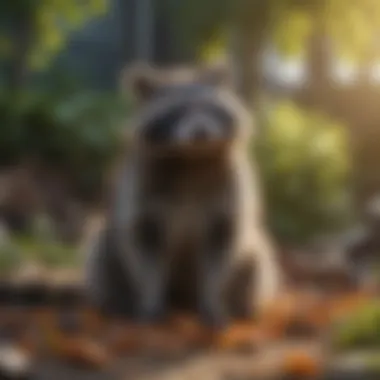Understanding Fat Raccoons: Biology and Behavior


Nature Topic Overview
This article explores the fascinating subject of fat raccoons. These creatures have interesting biology and behavior that adapt well to urban environments. Raccoons are typically known for their cleverness and curiosity, often seen rummaging through trash cans for food. In urban areas, they grow larger due to easy access to food sources. As we examine the lifestyle of fat raccoons, we uncover how their interactions with humans affect their health and size.
Fat raccoons are not merely a curiosity; they represent a fascinating adaptation to urban living. Their robust size may first appear amusing or endearing, but it also points to important ecological issues concerning wildlife and habitat coexistence. This article aims to provide insights into how these clever mammals thrive where food is plentiful but also why managing their populations becomes essential.
Fun Facts and Trivia
Raccoons are quite unique animals. Here are some fun facts:
- Raccoons belong to the Procyonidae family, which means "before the dog" in Latin.
- They have front paws that are remarkably similar to human hands. This helps them open containers and doors.
- Their signature mask-like facial markings help reduce glare, improving their night vision.
- Fat raccoons can weigh up to 40 pounds, especially in areas where food is abundant.
These facts might surprise young readers and spark their curiosity about wildlife.
Wildlife Explorations
Besides the common raccoon (Procyon lotor), there are various other species within the Procyonidae family. Animals such as the ringtail and the coati are also captivating subjects for exploration. Raccoons are omnivorous, feeding on diverse diets that include fruits, insects, and small animals. This adaptability makes them survivors in different habitats.
In the forests or towns, raccoons play a critical role in the ecosystem. They help with seed dispersion, contributing to plant growth in their environments. Similar creatures can often be examined in the same habitats, such as opossums or skunks.
Environmental Awareness
Housing fat raccoons shows the importance of conservation. Urban development often disrupts wildlife habitats and sources of food. It is essential for communities to understand their impact on wildlife.
Children can play a role in protecting raccoons and their habitats through simple steps such as:
- Not littering and keeping parks clean.
- Keeping food stored securely to avoid attracting wildlife.
- Learning about the importance of native species and local conservation efforts.
"Every small action counts when it comes to protecting nature."
DIY Nature Activities
Engaging with nature can be fun and educational. Here are some activities kids can try:
- Create a Raccoon Mask: Using paper and art supplies, children can create their own raccoon masks inspired by the animals' distinctive features.
- Nature Scavenger Hunt: Organize a scavenger hunt in your backyard or local park to research urban wildlife and find items like leaves, rocks, and signs of raccoons.
- Binocular Exploration: Use binoculars to observe wildlife from a distance. This can help children appreciate animal behaviors without disturbing them.
By learning about fat raccoons and their environment, kids can develop a deeper appreciation for nature.
Overall, this comprehensive exploration of fat raccoons emphasizes understanding their biology, behavior, and relationship with human environments. The content is crafted to engage a young audience while providing valuable insights into wildlife and ecological awareness.
Foreword to Raccoons
Raccoons are a fascinating species that play an intriguing role in our ecosystems. A comprehensive understanding of these animals lays the groundwork for exploring the phenomenon of fat raccoons. This section examines their basic characteristics, history, and significance. By starting with a discussion of what raccoons are, we set the stage for deeper exploration in later sections.
What are Raccoons?
Raccoons are medium-sized mammals native to North America. They typically weigh between 10 to 30 pounds but can exceed that in urban areas, contributing to the focus on fat raccoons. Known scientifically as Procyon lotor, they are easily recognized by their distinctive black 'mask' and ringed tail. Raccoons have dexterous front paws, allowing them to manipulate their environment skillfully.
In terms of diet, raccoons are omnivorous, meaning they eat both plants and animals. This adaptability helps them thrive in various habitats. They forage for food at night, showing nocturnal behavior, which is vital for their survival in both urban and rural settings. Their resilience makes them fascinating subjects of study.
Historical Significance of Raccoons
Historically, raccoons have captured human interest for centuries. Indigenous peoples across North America viewed them as symbols of resourcefulness. They often appear in folklore and stories, highlighting their cleverness and adaptability. Raccoons have also impacted agriculture and urban life. They can help in controlling pest populations but can also pose challenges when they raid crops and garbage.


As cities have expanded, raccoons have adapted remarkably to urban spaces. This historical context illustrates the changes and pressures raccoons have faced over time. Understanding these factors is essential for conservation efforts and managing human-raccoon interactions in the modern world.
"Raccoons exemplify adaptability, thriving in environments shaped by human activity."
Through this introduction, we appreciate both the biological and cultural significance of raccoons. This knowledge prepares us for a more in-depth analysis of their physical characteristics and behaviors in the upcoming sections.
Physical Characteristics of Raccoons
Understanding the physical characteristics of raccoons is essential for several reasons. First, these traits influence their behavior and adaptability in various environments. Second, the physical features give insight into their health and potential issues that arise from urbanization. Lastly, knowing these characteristics aids in wildlife management and conservation efforts. Here, we explore the unique body structure and the growing phenomenon of obesity among raccoons.
Body Structure and Adaptations
Raccoons have a distinct body structure that contributes to their adaptability. Their bodies are stout with an average length of about 24 to 38 inches, not including their bushy tails, which can add around 16 to 28 inches more.
They possess strong limbs that allow them to climb and dig effectively. Their dexterous front paws are particularly interesting. Raccoons can grasp objects with their paws, which resemble human hands in their dexterity. This adaptation is critical for their feeding habits, as they often manipulate food and other items in their environment. The fur on their bodies is typically grayish-brown, with some whites and blacks that help camouflage them in their natural habitats, especially during the night, which is when they are most active.
Furthermore, raccoons have a keen sense of touch. Their front paws have sensitive fur that detects changes in their surroundings, helping them to find food and navigate complex terrain. This sensitivity is an important evolutionary adaptation.
The Phenomenon of Obesity in Raccoons
Obesity in raccoons has become an increasingly noticeable phenomenon, particularly in urban settings. Several factors contribute to this issue. Firstly, the availability of food in cities vastly exceeds that in their natural habitats. With abundant waste from restaurants, households, and parks, raccoons find it easy to gain weight.
A chubby raccoon may look cute, but the reality is concerning. Excessive weight can lead to serious health issues. Common conditions linked to obesity include:
- Diabetes
- Heart disease
- Joint problems
These health problems can reduce their life expectancy significantly. Raccoons that live in urban areas may not reach their full potential lifespan of about 2 to 3 years in the wild, as obesity-related diseases take a toll on their lives. Managing raccoon populations and their access to food sources in cities is an ongoing challenge that requires public awareness and action.
Quote: "The rapid weight gain in urban raccoons is not just a reflection of their diet, but also a sign of how effectively they adapt to new environments."
In summary, by understanding the physical characteristics of raccoons, including their unique body structure and the health implications of obesity, we can better appreciate the complexities of these animals. This awareness is crucial for promoting conservation efforts and ensuring the wellbeing of raccoons in both rural and urban landscapes.
Behavioral Traits of Raccoons
Understanding the behavioral traits of raccoons is essential in exploring the complexities of these creatures, especially regarding their ability to adapt in various environments. Their behaviors not only impact their survival but also influence their size, particularly in urban settings. Raccoons exhibit behaviors that are directly correlated with their feeding habits and social interactions. These behaviors are shaped by their environment, which can range from dense forests to bustling cities. By examining these traits, we gain insights into how raccoons thrive and the challenges they face.
Feeding Habits and Diet
Raccoons are known for their diverse and opportunistic diets. They are classified as omnivores, meaning they consume both plant and animal matter. Their feeding habits can vary significantly depending on the availability of food sources. In the wild, raccoons will eat fruits, nuts, insects, and small animals. In urban areas, they often scavenge for human food, which can include garbage, pet food, and compost.
Their adaptability in diet is a major factor contributing to their size. Urban raccoons tend to grow larger than their rural counterparts due to the abundance of easy food. A few common types of food that raccoons enjoy include:
- Fruits: Apples, grapes, and berries.
- Meats: Small rodents, bird eggs, and fish.
- Human Food: Leftovers and food scraps.
This wide range of food sources contributes to nutritional variety, which can lead to significant weight gain and the phenomenon of obesity among raccoons in urban settings.
Social Structure Within Groups
Raccoons are social animals that often live in groups known as "gaze" or "nursery" groups. These groups can consist of family members, typically mothers and their young. Social behavior in raccoons is influenced by their environment, which in turn affects their growth and health.
Within these groups, you will find various social structures and dynamics. Some common behaviors observed include:
- Cooperative foraging: Young raccoons often learn from adults about finding food, an essential skill in the wild.
- Communication: Raccoons communicate through vocalizations, body language, and even facial expressions. This helps them to maintain group cohesion.
- Play: Young raccoons engage in play to develop essential survival skills, such as climbing and wrestling.
Such social interactions are crucial for their development and survival. Understanding these aspects can help inform conservation efforts, ensuring these adaptable animals continue to thrive in changing environments.


Habitat Preferences
Understanding the habitat preferences of raccoons is crucial to grasping how their lifestyle, behavior, and health are influenced by their surroundings. Raccoons are highly adaptable creatures capable of thriving in various environments. This adaptability plays a significant role in their growth, particularly in urban settings where food sources are plentiful.
Examining the nuances of their habitats helps reveal why some raccoons become more fat than others. The analysis extends beyond mere geographical distribution; it also includes how raccoons interact with their habitat. Thus, it is essential to explore both their natural habitats and their adaptations to urban settings.
Natural Habitats of Raccoons
Raccoons are native to North America and are mostly found in wooded areas, wetlands, and near rivers and streams. These environments provide the essential resources needed for survival. The availability of water, food, and shelter is critical for them.
In these natural habitats, raccoons tend to eat a varied diet, including fruits, nuts, insects, and fish. The diversity of food helps them maintain a balanced diet, reducing the risk of obesity and related health issues.
Some specific characteristics of natural habitats include:
- Dense Vegetation: Provides cover and safety from predators.
- Water Bodies: Essential for drinking and finding food.
- Rich Soil: Supports various plants that contribute to their diet.
As an omnivorous species, raccoons utilize their agile paws to dig and search for food. The combination of their physical adaptations and the abundance of natural resources in these habitats contributes to their overall health and well-being.
Urban Adaptations and Public Spaces
In recent years, raccoons have increasingly adapted to urban environments, often thriving in areas populated by humans. Cities provide abundant food sources that can sometimes be more attractive than their natural habitats. The presence of litter bins, outdoor dining areas, and poorly secured garbage presents raccoons with easy feeding options.
Key elements of urban adaptation include:
- Increased Food Availability: Raccoons find diverse food sources in cities. This often results in rapid weight gain.
- Shelter and Nesting: Buildings, parks, and gardens can offer safe places for raccoons to build their homes.
- Less Natural Predators: Urban areas typically have fewer natural dangers for raccoons. This protection allows populations to flourish.
Human-raccoon interactions are on the rise, and while this presents opportunities for raccoons, it also raises questions about their long-term health and well-being. As they adapt to public spaces, both raccoons and humans must navigate the challenges brought about by these changing habitats.
Impact of Urbanization on Raccoon Growth
The impact of urbanization on raccoon growth is significant. Urban environments provide unique challenges and opportunities for wildlife. As cities expand and develop, they alter the natural habitats of many creatures, including raccoons. Understanding how urbanization affects these animals is crucial. This section explores two main factors influencing raccoon growth: food availability and human interactions.
Food Availability in Cities
Raccoons are opportunistic feeders. In urban areas, they find a diverse range of food sources. This abundance influences their size and health. Common food items include:
- Garbage: Raccoons often scavenge through trash cans for leftover food.
- Pet Food: Food left out for pets becomes an easy target.
- Fruits and Vegetables: Gardens can provide additional food.
In cities, raccoons can grow larger than their rural counterparts. The consistent access to food contributes to their overall size, often leading to obesity. Urban environments are rich in calories, which helps the raccoons thrive. However, it is essential to recognize that this can also lead to health issues.
Human-Raccoon Interactions
Urbanization changes the way raccoons and humans interact. As humans expand into raccoon habitats, these animals adapt in various ways. They become more accustomed to human presence and often learn to navigate urban environments successfully. Key points include:
- Increased Encounters: Raccoons may venture closer to humans when searching for food, leading to potential conflicts.
- Awareness of Danger: Raccoons adapt to human behaviors, becoming more cautious but also bolder when food is involved.
Urban raccoons often develop unique behaviors not seen in their wild counterparts. Understanding these interactions is crucial for effective management.
Educational programs can help communities understand how to coexist with raccoons, reducing negative encounters. Awareness and proper waste disposal can minimize the resources available to raccoons, thus influencing their growth and health.
Overall, urbanization presents both opportunities and challenges for raccoon populations. By examining food availability and human interactions, we can better understand the dynamics of raccoon growth in urban settings.
Health Consequences of Obesity in Raccoons
Understanding the health consequences of obesity in raccoons is essential to grasp their adaptation in urban environments. As these animals thrive in cities, they often access abundant food sources. This can lead to increased body weight, which influences their overall well-being. The study of these impacts not only benefits raccoon populations but also aids in wildlife management and conservation strategies.


Common Diseases and Conditions
Obesity in raccoons presents various health risks. Just like humans, raccoons can develop a range of diseases linked to excess weight. These include:
- Diabetes: This condition occurs when raccoons cannot regulate blood sugar levels properly.
- Arthritis: Increased weight puts pressure on joints, leading to pain and mobility issues.
- Heart Problems: Obese raccoons are at higher risk for cardiovascular diseases, similar to humans.
- Liver Disease: Fatty liver disease can develop, which is life-threatening.
Through studies, researchers find that overweight raccoons show signs of these conditions early in life. This emphasizes the need for monitoring their health in urban areas.
Life Expectancy and Quality of Life
The life expectancy of a raccoon can be significantly influenced by its weight. Generally, healthy raccoons live up to 3 years in the wild and 7 years in captivity. However, obesity shortens this lifespan. Overweight raccoons face challenges that impact their ability to hunt, mate, and escape from predators. They often exhibit a lower quality of life due to health issues and difficulties in mobility.
Research indicates that raccoons with healthy weights display more agility and stamina. This enhances their survival in the wild, supporting the idea that maintaining a balanced weight leads to a better life overall.
Conservation and Management of Raccoons
Effective conservation and management of raccoons is crucial in maintaining the balance between wildlife and urban environments. Raccoons have adapted remarkably well to urban settings, leading to a significant rise in their population. This growth can result in conflicts between humans and raccoons, especially when it comes to food sources and habitat encroachment. Therefore, addressing the challenges of raccoon management is essential for both species' well-being and for urban ecosystems.
One of the main points to consider in raccoon conservation is the need for humane control methods. These methods focus on minimizing harm to the animals while managing their populations. Effective practices can include live trapping and selective sterilization programs, making sure that raccoon populations remain stable without resorting to lethal control. Understanding the proper techniques and protocols for humane control can help protect wildlife while addressing concerns related to overpopulation.
Another vital aspect is public education and awareness. Teaching communities about raccoon behavior and their role in the ecosystem encourages coexistence rather than conflict. Well-informed citizens can take preventive measures, such as securing food sources and reducing attractants. By fostering a deeper understanding of these creatures, communities can work together to support raccoon conservation efforts.
"By striking a balance between raccoon management and community awareness, we ensure a healthier coexistence for both humans and wildlife."
Furthermore, regular monitoring of raccoon populations allows for timely interventions and responses to any emerging issues. This is particularly important in cities, where human and animal interactions are frequent. Implementing guidelines and best practices for urban wildlife management can lead to more successful outcomes in conservation.
In summary, the conservation and management of raccoons requires a multifaceted approach. By focusing on humane methods and increasing public awareness, we can promote a respectful relationship between humans and raccoons. Understanding the significance of these strategies will contribute to the well-being of raccoons and their habitats.
Humane Methods of Control
Humane methods of control are essential for the management of raccoon populations. Instead of resorting to destructive measures, these approaches prioritize the welfare of the animals involved. Some common humane strategies include:
- Live trapping: Utilizing traps designed to capture without injury ensures raccoons can be safely relocated.
- Sterilization: Programs aimed at reducing future populations can involve sterilizing adult raccoons.
- Habitat modifications: Making areas less attractive to raccoons by securing trash and controlling access to food can prevent population increases with minimal interference.
When employing humane methods, collaboration with wildlife rehabilitation experts is crucial. These professionals can guide community efforts to ensure the approaches are effective and ethical.
Public Education and Awareness
Public education plays a vital role in the conservation of raccoons. Increasing community awareness can lead to better understanding and cooperation in managing raccoon populations. Key points for public education include:
- Understanding raccoon behavior: Educating the public about natural behaviors can alleviate fears and misconceptions.
- Preventing conflicts: Teaching preventive measures, like securing garbage and pet food, helps reduce unwanted encounters.
- Promoting coexistence: Highlighting the benefits of raccoons in the ecosystem can encourage people to see them as valuable neighbors rather than pests.
Creating informative resources like brochures or workshops can empower communities to participate in conservation. When people are equipped with knowledge, they can actively contribute to maintaining harmony with their local wildlife.
The End
In concluding our examination of fat raccoons, it becomes clear that this topic holds significant relevance in understanding their ecological impact and interactions with humans. The exploration of their biology, behavior, and health provides insights into how urban settings influence raccoon populations. Recognizing these factors highlights the adaptability and resilience of these animals, showcasing their success in changing environments.
Summary of Key Points
Throughout the article, several key aspects of fat raccoons have been addressed:
- Physical Characteristics: The typical features of raccoons, including their body structure, which often contributes to increased weight, were discussed.
- Obesity Phenomenon: We examined how urban environments provide abundant food sources leading to obesity among raccoons.
- Behavioral Traits: The feeding habits and social structures were emphasized, illustrating how these traits support their thriving in cities.
- Health Risks: Obesity-related health issues were outlined, emphasizing the need for monitoring raccoon health to ensure their well-being.
- Conservation Efforts: Various methods to manage raccoon populations humanely were presented, alongside the importance of public education.
Future Research Directions
Looking ahead, further research can enhance our understanding of fat raccoons. Key areas for potential study include:
- Urban Ecology Studies: Investigating how urban planning affects wildlife, particularly raccoons, may provide insights for better coexistence strategies.
- Health Risk Assessment: Longitudinal studies on raccoon health can reveal the long-term impacts of urban living, especially connected to obesity.
- Behavioral Adaptations: Tracking behavioral changes in raccoon populations in different urban areas could highlight evolutionary responses.
- Public Awareness Campaigns: Effective education methods on human-wildlife interactions can help reduce negative encounters and promote coexistence.
In summary, understanding fat raccoons not only adds to our knowledge of raccoon biology but also aids in developing strategies for their management and conservation in urban ecosystems.







